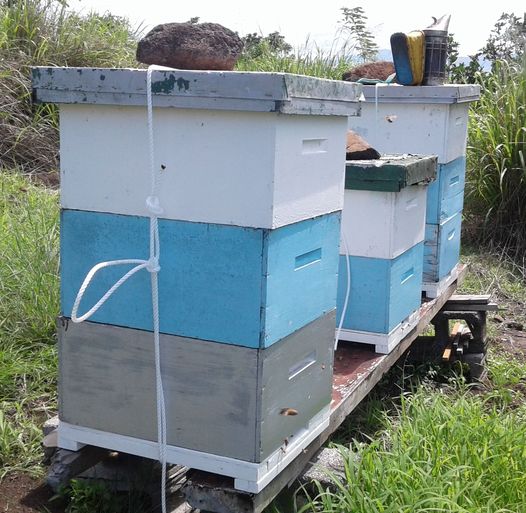Impacts
Cyclones can cause strong winds that can push bee hives over and cause flash flooding which can wash bees away.
Cyclones also impact on available food resources for bees (flowering trees).
Being prepared and knowing what to do following a storm can help to reduce the impact cyclones for beekeepers and their bees.
Experience in Fiji suggests that the main difference between losing only 10-20% of bee colonies and losing 70% or more was whether the beekeeper roped or strapped the hives so that the hive bottom, boxes and lid all stayed together with the frames inside.
The hives will topple over, but can be lifted upright shortly after the cyclone and later put back on a hive stand.
Without a rope around the hive, the frames will likely be scattered outside the boxes and the bees lost.
A stable hive stand and not having hives too far off the ground will also help.
There are more elaborate and better ways to protect hives, but a rope (or two) cinched around the hive is a cheap solution that worked well in past cyclone events.

18 ways to keep bees safe during and following a cyclone
- Safety first. This is obvious, but remember that your life is more important than your bees. Never put yourself or other people at risk for your hives.
- Start early. As with home preparation, it is better to prepare your apiary and beekeeping response sooner rather than rushing or panicking later.
- Store some sugar. After the storm, your bees’ food supply may have been destroyed. You will want to be able to supply them with something to eat right away. Feed dry sugar and keep records of what comes into flower first after weather events.
- Repair beekeeping equipment. Seal any cracks or holes in old bee boxes to reduce exposure to wind and rain.
- Move bees where appropriate. If bees are located in high wind area or areas which may flood, it may be suitable to close entrances in the evening and move bees into a shed or other area for 48hrs while the storm passes. Don’t put bees in the house or in sheds near houses!
- Mark hive location. If you want to return the hives to where they were before the cyclone, especially if you have a lot of hives to manage, take note of the position/location of each hive and write it down for future reference.
- Reduce entrance as small as you can. If it’s not appropriate to move bees, closing the entrance fully helps prevent wind and water from getting into the hive but, depending on the season, may also create unsafe high-temperature conditions inside or prevent an escape by bees in the event one is needed. This is why it can be good to reduce the entrance as much as possible without closing it up entirely. In the event of rising water or the hive being knocked into water, this can give your bees a last-chance escape route. Additionally, after the cyclone, if you are not able to get to your hives immediately, this allows bees to exit the hives.
- Move bees away from trees, power lines, and other hazards. You don’t want your hives crushed by falling trees or electrocuted by a live wire during a storm. If you can, move hives away from potential hazards.
- Place them on high ground. One major threat to hives during a cyclone is flooding. Keep bees up off the ground, but note that placing bees higher means they are potentially more exposed to more wind.
- Close up screen bottom boards. A broken window in a home during a cyclone can result in dangerous wind tunnels, and similarly, high winds during a cyclone are dangerous for bees and can create a high-pressure environment inside a hive. Many beekeepers make wind barriers with cardboard in order to help prevent a potential wind tunnel.
- Tilt the hives. Tilting hives forward can be important, where possible. This will help water exit the hive in the event of water getting in.
- Secure hives together and/or to a heavy object & strap hives down. You will need ratchet straps or rope and ground anchors (e.g., fence post/star pickets) to secure your hive. Securing the hives with ratchet straps or rope will help to keep it in one place and one piece. Consider securing the hives both horizontally and vertically, and securing them all together if you have multiple hives.
- Put away all apiary equipment. Your apiary equipment should be stored away safely. You don’t want your tools to become dangerous flying projectiles…or to fly away and never be seen again!

Caring for bees after the storm
- Be prompt to clean up dead hives. Hundreds of dead bees will stink after just a few days. Don’t hesitate to clean them up. If bees have American Foulbrood Disease (AFB) this is a major issue that may impact on your entire apiary.
- Don’t bother your bees too much. Put them back together, but leave bees to settle for a week or so as the bees will likely be cranky, hungry, and defensive after a storm. Be ready to use full protective equipment, including gloves, a bee veil and suit and footwear.
- Feed your bees. After a storm, flowers, vegetation, and other things that the bees eat may have been blown away. Keeping sugar and water on hand for sugar feeding can prevent starvation after the fact.
- Watch for robbing afterwards. Dearth created by all the flowers and plants being blown away will affect all hives (including neighbouring and wild hives) in the area.
- Reach out to your local bee associations and departments. If you need help with your bees after the storm, your local bee association is usually a great resource. Or you may be able to offer a helping hand to another beekeeper in need in the aftermath

